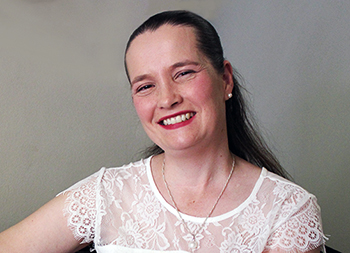
Dr Yolanda Kotzé, Affiliated Researcher in the
UFS Institute for Groundwater Studies, is passionate
about the management of groundwater.
Photo: Rulanzen Martin
An interest in groundwater resource management ignited the spark for a PhD research thesis by Dr Yolanda Kotzé, Affiliated Researcher in the Institute for Groundwater Studies (IGS) at the University of the Free State (UFS).
Her PhD research thesis titled, A Framework for Groundwater Use Authorisations as Part of Groundwater Governance in Water Scarce Areas within South Africa, was the result of her interest in groundwater resource management. Dr Kotzé identified the agricultural sector as one of the major water users, and a decision was made to conduct research within this sector.
Research funded by Institute for Groundwater Studies
Groundwater is water found underground in cracks and spaces in soil, sand, and rocks. It is stored in, and moves slowly through geological formations of soil, sand, and rocks (aquifers). The National Department of Water and Sanitation was indirectly the client for this research. The research project was funded by the IGS. Given the current drought, effective groundwater resource management can be achieved within all sectors through sustainable abstraction and use without over-abstraction.
“Groundwater can be effectively managed
in the agricultural sector by sustainable use,
monitoring the quantity of groundwater use,
and measuring groundwater levels,”
said Dr Kotzé.
Research addresses improvement of groundwater management
Her promotor, mentor, teacher, and friend, the late Prof Gerrit van Tonder, introduced her to the field of Geohydrology, and especially to groundwater resource management. “With my research, I made a significant contribution to the improvement of groundwater governance and groundwater resource management, as well as to the handling of groundwater use authorisations for irrigation purposes in South Africa,” said Dr Kotzé. With this significant contribution, she attempts to address the phenomenon of poor groundwater allocation and groundwater resource management by means of a framework. The development of this framework has shown the value of action research in an attempt to find a solution to a problem. “Groundwater can be effectively managed in the agricultural sector by sustainable use, monitoring the quantity of groundwater use, and measuring groundwater levels,” said Dr Kotzé.
The methodology of the research consisted primarily of action research, which has a five-phase cyclical process. The research was Dr Kotzé’s application for a PhD in Geohydrology at the UFS in 2012. The research was completed in 2015.